This is a Zeiss-Ikon Voigtländer Vitessa 1000SR, a 35mm rangefinder camera produced under both the Zeiss-Ikon and Voigtländer names from about 1967 to 1970. This camera’s dual branding was a byproduct of Zeiss-Ikon’s 1965 merger with Voigtländer AG. Despite having the Zeiss-Ikon name, the camera was entirely designed and built in Voigtländer’s Braunschweig factory and uses their Vitessa name, which the company had used on other models dating back to 1950. The Vitessa 1000SR was the highest featured of a new generation of Vitessa cameras, being the only one with the Prontor 1000 LK shutter, capable of a top 1/1000 shutter speed. The camera also has a coupled rangefinder and a CdS exposure meter with a viewfinder match needle for correct exposure.
Film Type: 135 (35mm)
Lens: 42mm f/2.8 Carl Zeiss Tessar coated 4-elements
Focus: 3.5 feet to Infinity
Viewfinder: Coincident Image Coupled Rangefinder
Shutter: Prontor 1000 LK Leaf
Speeds: B, 1 – 1/1000 seconds
Exposure Meter: Coupled CdS Cell w/ Viewfinder Match Needle
Battery: 1.35v PX625 Mercury Battery
Flash Mount: Hot shoe synchronized at all speeds
Weight: 517 grams
Manual: https://www.cameramanuals.org/voigtlander_pdf/voigtlander_vitessa_1000_sr.pdf
How these ratings work |
The Zeiss-Ikon Voigtländer Vitessa 1000SR is a unique camera that has an undeniable 1970s styling, but is built to a quality standard reminiscent of cameras both Zeiss-Ikon and Voigtländer had produced decades before. The camera has an excellent viewfinder, a capable shutter and lens, and a metering system that gives match needle convenience with full manual control. This list of features makes it the most desirable of Vitessa cameras from this period, not only because of it’s specs, but also that it uses an easily substituted PX625 battery. This is a cool camera that’s just as capable and fun to use any rangefinder from the era. | ||||||
| Images | Handling | Features | Viewfinder | Feel & Beauty | History | Age | |
| 2 | 1 | 1 | 2 | 2 | 1 | 20% | |
| Bonus | +1 for overall excellence, this is a very cool camera that is worth seeking out | ||||||
| Final Score | 11.8 | ||||||
History

In the 1960s, the German camera and optical industries were struggling. Compared to their near monopoly of photographic goods before and during World War II, now German manufacturers faced stiff competition from Japanese and in some cases, Soviet manufacturers. Long time German companies like Zeiss-Ikon and Voigtländer were deep in tradition and were seen by outsiders as stubborn and slow to adopt new technologies. Although each company had produced some of the greatest and most innovative cameras of the 20th century, they struggled to keep up with the near constant innovation of Japanese companies like Nippon Kogaku (Nikon), Canon, Chiyoda Kogaku (Minolta), Asahi Optical (Pentax), Konishiroku (Konica), Kuribayashi (Petri), Tokyo Kogaku (Topcon), Mamiya, Riken, Miranda, Olympus, and others.
In East Germany, Dresden area manufacturers like KW, Ihagee, Certo, Balda, Welta, Zeiss-Ikon Dresden, Altissa and others were being combined into a single, government controlled entity called VEB Pentacon Dresden.
In West Germany, the government did less to dictate the fate of the companies there, but by the mid 1960s, it became clear that in order for many of these companies to survive, a merger was necessary so in 1965, two of Germany’s oldest and most successful marques, Zeiss-Ikon and Voigtländer merged together to create a single Zeiss-Ikon Voigtländer company. A merger of two big names was a big deal, as it would be like today if General Motors and Ford were to merge together to form a single company.
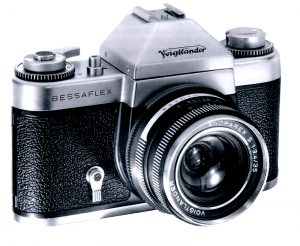
The first product of the new Zeiss-Ikon Voigtländer came in 1966. The Icarex 35 was a 35mm SLR originally developed by Voigtländer as the Bessaflex that was to replace their aging leaf shutter SLR, the Bessamatic. Both Zeiss-Ikon and Voigtländer had produced SLRs before, but they were either leaf shutter designs, or in the case of the Zeiss-Ikon Contarex, used an extremely complicated lens mount and shutter design that was prohibitively expensive to manufacture and sell.
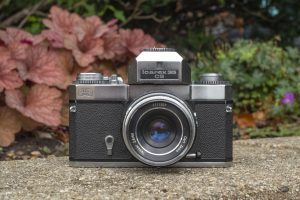
This is just my own guess, but it seems that the Bessaflex prototype was very attractive to Zeiss-Ikon as they didn’t have anything to compete with the huge influx of Japanese focal plane SLRs that were heavily preferred over leaf shutter SLRs and rangefinders. Adapting the Bessaflex to a Zeiss-Ikon product would have taken far less time than designing an all new camera. When it was first released, the Icarex 35 only featured the Zeiss-Ikon logo, and it was not until the later Icarex 35 CS model that the name Voigtländer appeared anywhere on the camera.
Although a fine model, the Icarex 35 was still expensive, and there was still a market for 35mm rangefinder cameras, so the second camera to be released under the new merged company was another Braunschweig built camera called the Vitessa 500. Although sharing the same Vitessa name as the earlier barn door Vitessa from 1950, the camera was not at all related.
There were four Vitessa 500 models released between 1966 and 1970, all featuring a Prontor leaf shutter with a top speed of 1/500, electronic flash hot shoe synchronized at all speeds, and the following features:
- Vitessa 500L – Selenium light meter, scale focus, mechanical Prontor 500 CK shutter, and Color Lanthar 42mm f/2.8 triplet lens
- Vitessa 500S – Same as 500L except CdS light meter, zone focus with viewfinder icons, and electronic Prontor 500 LK shutter
- Vitessa 500AE Electronic – Same as 500S except now with shutter priority AE and uses 2x PX825 mercury batteries
- Vitessa 500SE Electronic – Same as 500AE Electronic except Carl Zeiss Tessar 42mm f/2.8 4-element lens

All four models shared the same boxy chromed metal and plastic body with a black pebbled body covering. Due to the larger size of the PX825 battery chambers on both the AE and SE models, the front of the camera sticks out a little farther than the other two. A small number of AE and SE models came with a fake wood veneer body covering in place of the black leatherette giving them a very distinct look. These cameras have no other differences from the non-wood AE and SE models, and aren’t even indicated as being a different model anywhere on the camera.
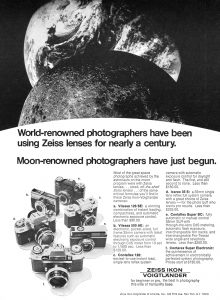
Shortly after the release of the first four models, a fifth and final model, called the Vitessa 1000SR was released, using the same body as the previous four, but with the smaller battery compartment of the 500L and 500S. As the name implies, the 1000SR had a top speed of 1/1000 via a new mechanical Prontor 1000 LK shutter, a coupled coincident image rangefinder, a CdS exposure meter with match needle read out, and the 4-element Carl Zeiss Tessar 42mm f/2.8 from the 500SE.
Although lacking in automatic exposure, the Vitessa 1000SR had all of the best features of the previous models, adding the faster 1/1000 shutter speed and coupled rangefinder. As a bonus, the 1000SR uses a single PX625 battery, which not only makes the body smaller, but is much easier to substitute today than the larger twin PX825 batteries of the 500AE and SE. The battery is only used for the meter, so with a dead battery, the camera could still be used manually.
The short Lab Report above comes from July 1970 and gives a short summary of the Vitessa 1000SR and some technical details. Reviewer Steven Barron remarks at how compact the camera is, saying that it easily fit into a front suit pocket, but that at times the camera might be too small. His biggest (and only) complaint was the small size and location of the front focusing ring which made it hard to grip without accidentally smudging his fingers on the lens.
In the technical section, Norman Goldberg called the inclusion of the Zeiss Tessar to be a high performance lens in an amateur-grade camera and remarked that although he was able to detect some optical anomalies, they were very minor and well within the expectations of people in this camera’s demographic. The overall review was positive with the best remarks coming from the Prontor shutter’s top 1/1000 shutter speed which was said to freeze motion of a car traveling at 55mph.
With a retail price of $139.95, which when adjusted for inflation compares to around $940 today, the Vitessa wasn’t inexpensive, yet was still cheaper than professional level SLRs and rangefinders of the day.
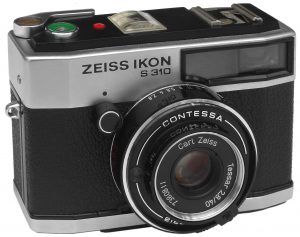
The Vitessa 1000SR would be the last camera produced with both the Zeiss-Ikon and Voigtländer name and would be replaced in 1970 by the Zeiss Ikon Contessa S 310 and it’s rangefinder equipped Contessa S 312. These cameras were reportedly built by Voigtländer in Braunschweig, but only branded using the Zeiss-Ikon name.
It would not be until after 1972, when parts of the company, including the Voigtländer brand would be sold to Rollei-Werke Franke & Heidecke who would later release another camera bearing the Voigtländer name. Other parts of the company would revert back to the Carl Zeiss Foundation who would license the Contax brand name and Zeiss lenses to Yashica, a Japanese company who in 1975 would release a Japanese built semi-professional Contax RTS SLR.
Today, the most popular Vitessa cameras are the earlier 1950s models that consist of the original “barn-door” models like the Voigtländer Vitessa L, and the later DKL mount Vitessas. The Zeiss-Ikon branded Vitessas hardly show up on most collector’s radar, with many of them not even knowing of the Vitessa 1000SR’s existence. Of the five models in this series, the 1000SR is a very capable and fun to use camera that is worth looking out for, and one I highly recommend.
My Thoughts
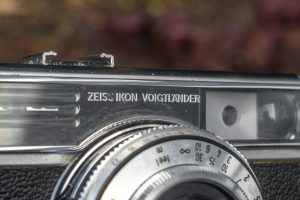
I recall seeing one of the Zeiss-Ikon Voigtländer Vitessa cameras a while back and my first impression was that it did not capture my interest…at all. From a glance, this looks like a huge number of boxy low-end cameras that became common in the late 1960s and throughout the 70s, most of which either used 126 Instamatic film, or had cheap single speed shutters and fully automatic operation.
It wasn’t until I stumbled upon a review online claiming it to be a rangefinder with a Tessar lens that I took notice and once I realized that this fully mechanical metered rangefinder was far more than a cheap Instamatic, I set my sights on picking one up. Pictures of this camera online are misleading as it is hard to get a sense of scale with it. In some images, it looks barely larger than a cheap all-plastic point and shoot, and in others, it looks like an angled brick, like a German Argus C3.
When it arrived, I was immediately struck with how solid this camera is. Although there is plastic in various locations of the camera, a good portion of it’s body is still metal. With a weight of 517 grams, it’s not as heavy as the Argus C3, but it’s far sturdier and denser than just any old point and shoot camera.

The top of the camera is streamlined and free of clutter. With a nice Vitessa logo on the left and the flash hot shoe in the center, the only thing left is the large square shutter release button on the right, which is threaded for a cable release.
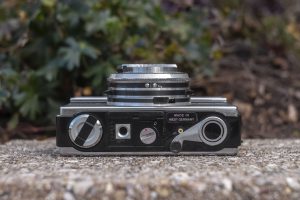
Whenever you have a camera with a clean top plate, you have to know those controls are just elsewhere on the camera, and with the Vitessa 1000SR, the bottom is where a good number of them are.
From left to right is the rewind know with fold out handle, 1/4″ tripod socket, battery compartment, film advance lever, and rounding it all out is a little sticker reminding you this camera was made in West Germany.
One thing that’s really nice about the 1000SR compared to other cameras in the Vitessa 500 series is that both the AE models have twin battery compartments on the front of the camera that use a much harder to substitute, PX825 battery. The 1000SR has the same single PX625 compartment as the Vitessa 500S which not only makes the camera smaller, but uses a battery that is much easier to find.
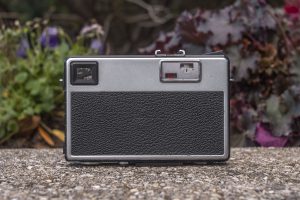
The back of the camera has a square viewfinder window in the extreme upper left corner, which makes it ideal for left-eye shooters such as myself as it allows the camera to be centered on my face, instead of off to the side like with cameras with a more centered viewfinder.
On the opposite side are two small plastic windows revealing both the exposure counter and a film transport indicator that spins as film passes over the geared shaft in the film compartment. The exposure counter counts up from 0 to however many exposures have been made, and can only be reset with the film door open.

Opening the film compartment requires you to press down on a sliding lock on the camera’s right side. Both sides of the camera have strap lugs for a neck strap which is unusual for a camera of this era as many contemporary cameras relied on the ever ready case for a strap.
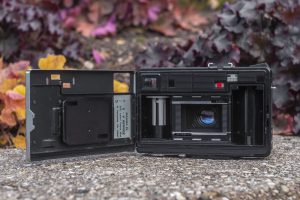
Film transports from right to left as is the case of most cameras with a film advance on the bottom. The non-removable take up spool is multi-slotted which makes loading film extremely easy. The distance from both the supply and take-up sides is very close to the film gate, which means that you waste less film at the beginning and end of a roll of film, suggesting you should be able to get an extra exposure or two out of each roll of film. The pressure plate on the door is flat metal and is very large, which should help maintain good film flatness as it transports through the camera.
As I mentioned above, only with the film door open can you reset the exposure counter, which you do by manually turning it with your finger until you get to a black rectangle, indicating the start of a new roll of film.
One last attribute of the camera is that the door channels are very deep requiring absolutely no light seals of any kind. This is a welcome thing to see as nearly every camera by the 1970s had switched to foam seals which have all degraded, requiring their replacement before you can use the camera.
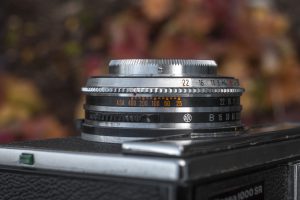
Up front, the rest of the camera’s controls are around the Prontor 1000 LK leaf shutter. The Vitessa 1000SR is fully mechanical, requiring a battery only for the meter, so you are free to choose any combination of shutter speeds from 1/15 to 1/1000 and f/stops from f/2.8 to f/22 as you wish. There is no coupled LVS to get into the way which makes me very happy as it makes using the match needle in the viewfinder really easy as both shutter speeds and f/stops can be used to match exposure.
In the image to the left, you can see ASA film speed numbers which can be changed by pressing a small black button and rotating the outer chrome ring to match whatever speed film is in the camera. I don’t show it, but on the opposite side of this ring is another set of orange numbers with corresponding DIN film speed numbers.
Without a doubt, my least favorite thing about the Vitessa 1000SR comes as a result of the company’s effort to make the camera compact, which is that the front lens focus ring is very small and caused me to fumble a number of times while I was out shooting. The is a small plastic protrusion that you can use or simply grip the entire ring. In an original review shared above from when the camera was new, reviewer Steven Barron remarks that the small focus ring was problematic as it often caused him to accidentally smudge the lens while reaching for it. I think that with regular use, you could get used to it, but it’s something that I fumbled about with more than once while using the camera.
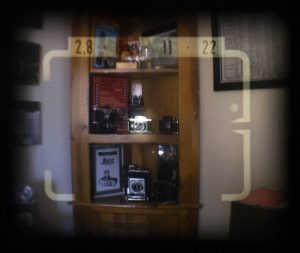
The viewfinder is large and bright, featuring a pink tinted viewfinder with frosted frame lines indicating the 42mm focal length of the lens and a circular rangefinder spot. On the right side is a notch for the match needle which is operated by the CdS meter on the front of the camera. Up top is a convenient scale showing you which f/stop you have selected. Finally, a small dot is on the right side, just above the match needle notch which is used to check the status of the battery. On the front side of the camera is a green button that when pressed, should move the needle to this location if battery power is sufficient.
The viewfinder is large enough that I could easily see the entire image within the frame lines even while wearing prescription glasses. The contrast from the frosted frame lines and rangefinder patch with the pink tint to the main viewfinder allowed me to easily focus the camera even in low light. I generally prefer cameras with rectangular rangefinder patches rather than circles, but this is but a minor nitpick to an otherwise very nice viewfinder. The previous image does not do the viewfinder justice as capturing the contrast and brightness of a camera’s viewfinder using a cell phone camera is difficult. In reality, the frame lines, match needle, aperture scale, and rangefinder patch are very easy to see.
Overall, the Vitessa 1000SR has a list of features and a build quality that seems higher than other Vitessa 500 cameras of the same era would suggest. Although very angular, most of the camera’s controls fell naturally where my fingers expected them, and I was optimistic about the results I might get while shooting it.
My Results
My first experience shooting the Vitessa 1000SR happened around the time I took my first stab at developing motion picture 35mm film using a chemical process called ECN-2. This process is similar to C41, but is designed specifically for film stocks like Kodak Vision3 as it both is able to remove the Remjet coating, but also gives more faithful colors.
I had previously developed Kodak Vision3 50D in regular C41, but that requires a separate step to remove the Remjet, so I was eager to see what ECN-2 would do. As a result, I loaded up several 35mm cassettes with the stuff and shot a bunch of it in late summer 2020, the first being in this Vitessa 1000SR.
I had pretty high expectations for the Vitessa 1000SR as I’ve shot numerous cameras with Zeiss Tessar lenses, and the camera seemed to be in perfect working order prior to using it.
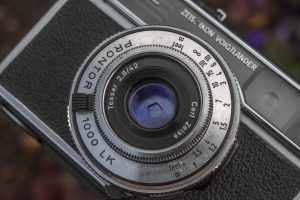
As I saw the images come out of my scanner, I was thrilled with not only the sharpness, but of the accurate exposure, suggesting that the CdS meter is still working as good as it did new, over 50 years ago. As is the case of all images taken with Tessar lenses, center sharpness is excellent with only the slightest hint of softness near the corners. There is an ever so slight amount of vignetting near the corners that is most easily seen in images where the sky is present. The image of the old barn in the gallery above shows it the most clearly, but it’s by no means distracting. It does not matter whether you are shooting an old folding camera, a screw mount Praktica, or a 1980s point and shoot, if it has a Tessar lens, you’re going to get great images.
While out and about with the camera, I had no major complaints, although I can’t say it was a perfect experience either. While the sharp angled corners look attractive on a shelf, and were consistent with popular design of the era in which the camera was made, it does somewhat restrict the camera’s ability to easily slide in and out of a pocket. With a wrist or neck strap, this isn’t an issue, but I suspect this camera was intended as an advanced snapshot camera, so having something that doesn’t get in the way of itself would have been more preferable.
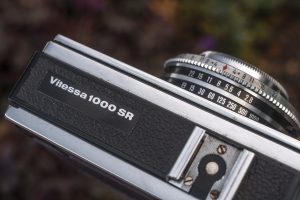
I also didn’t love the front element focus. Adding a helix, or even a larger ring for which to grip would have likely increased the cost, complexity, and size of the camera, so I can understand why it works the way it does, but it’s something that caused me to fumble a bit while using, and ever so slightly cheapens the experience of the camera.
These minor nitpicks aside, I really enjoyed using the Vitessa 100SR. The viewfinder size, contrast, location and layout are all excellent and one of the best I’ve ever used on a fixed lens rangefinder. The fully mechanical operation of the shutter without the annoyance of a coupled EV or LVS was a welcome change to other mid-century rangefinders. And of course, there’s that lens…
The Zeiss-Ikon Voigtländer Vitessa 1000SR is a mouthful of a name for a camera that offers a mouthful of goodness. It’s not perfect, but it doesn’t have to be. When compared to previous Zeiss-Ikon and Voigtländer cameras, the Vitessa 1000SR is modest, but the camera manages to squeeze in a tremendous amount of features into a compact size, so for the price it sold for, was a relative bargain.
Perhaps the most unfortunate thing about the Vitessa 1000SR is that it unfairly gets grouped into a category of less than inspiring cameras produced under both the Zeiss-Ikon and Voigtländer names in the 1960s and early 1970s. While not all cameras each company made during this time were terrible, many were, but this is definitely not one of them. It is certainly not perfect, but when working within it’s strengths, this is a very fun and capable camera with a distinctly period look and feel to it. Highly recommended!
Related Posts You Might Enjoy
External Links
https://casualphotophile.com/2020/07/17/voigtlander-vitessa-1000-sr-review/
https://oldcamera.blog/2013/03/20/zeiss-ikon-voigtlander-vitessa-100-sr/
https://www.rangefinderforum.com/forums/showthread.php?t=98506
https://www.mes-appareils-photos.fr/Voigtlander-Vitessa_1000_SR.htm (in French)
https://www.camarassinfronteras.com/vitessa_1000/vitessa_1000.html (in Spanish)


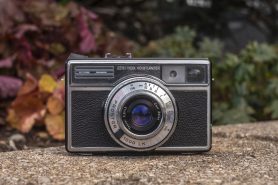
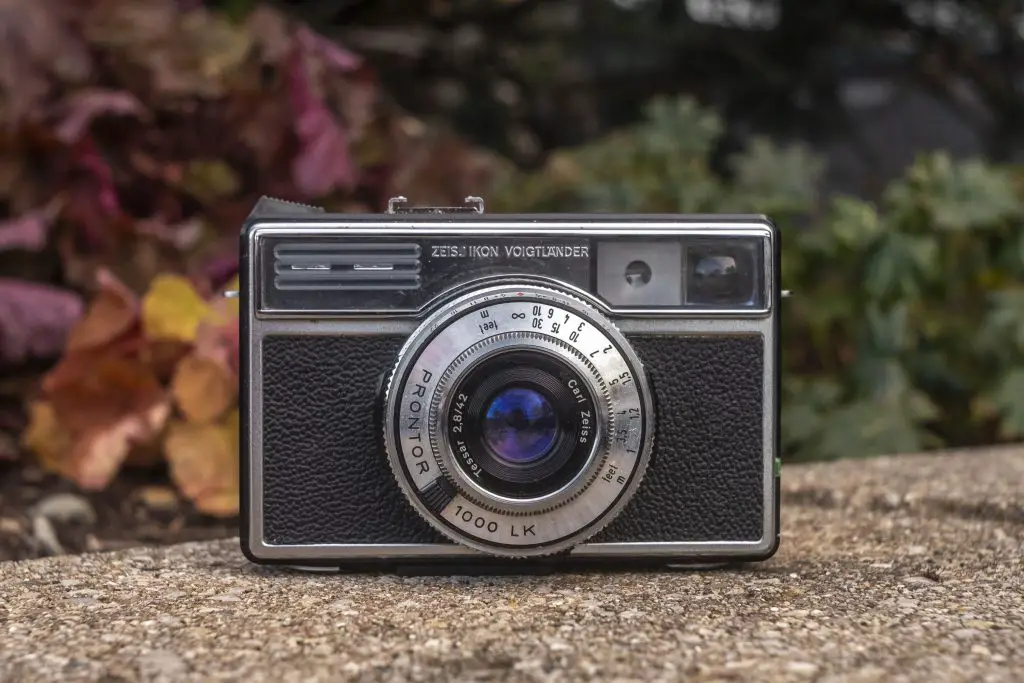
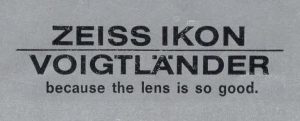
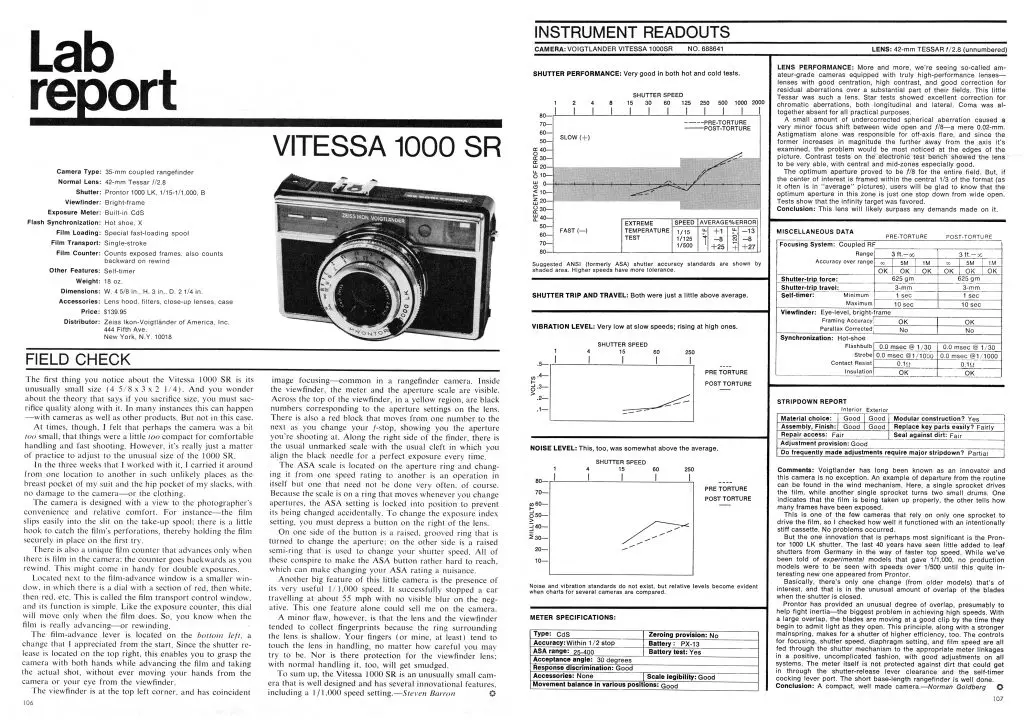















Great review Mike. I picked up one of these earlier this year. Unfortunately the first roll I put through came out unexposed 🙁 Not completely sure why but I think the shutter release button needs to go all the way down to operate and if I don’t quite press it all the way it only releases the winder lock. I need to try again and be more conscious of the button press.
Also Mike, my example came with a rubber lens hood which gives you something bigger to grab hold of for focusing so the issues you and others have with finding the small rig with you fingers is much reduced. being rubber it also folds near flat for easy stowage between shots.
Ya know, I never considered that. I should see if I have any hoods that will fit!
When you see a pseudo-wood trimmed Vitessa, think early 1960s Ford “Woody” station wagon – not a basement rec room. Way much cooler!
In the photo that shows the film transport, I saw the sticker for “Z-V Service.” I am pretty sure that’s where Ye Olde Rolleicord V went for a CLA and the installation of a Fresnel + split image focusing screen. A Zeiss Contaflex IV was also sent there for a tuneup, as well. I wonder if they’re still keeping German cameras going these days?
It’s very possible. As I’ve been collecting more and more cameras, I’ve seen a few stickers for people I recognize. I even have a Kodak Bantam Special that was previously serviced by Chris Sherlock!
Interesting little camera and great review! The square morphology reminds me of my Kodak Instamatic 500 (German-made) from 1964.
I was surprised that you said the lens on the 1000 was front element focus. The Voigtländer folding Vito cameras had front-element focus Skopar lenses (their version of the Tessar), but when they introduced the solid bodies, like the Vito B, the Color-Skopar lens became unit focus. The 50mm ƒ/3.5 Color-Skopar on my Vito BL is amazingly good for such a modest little lens.